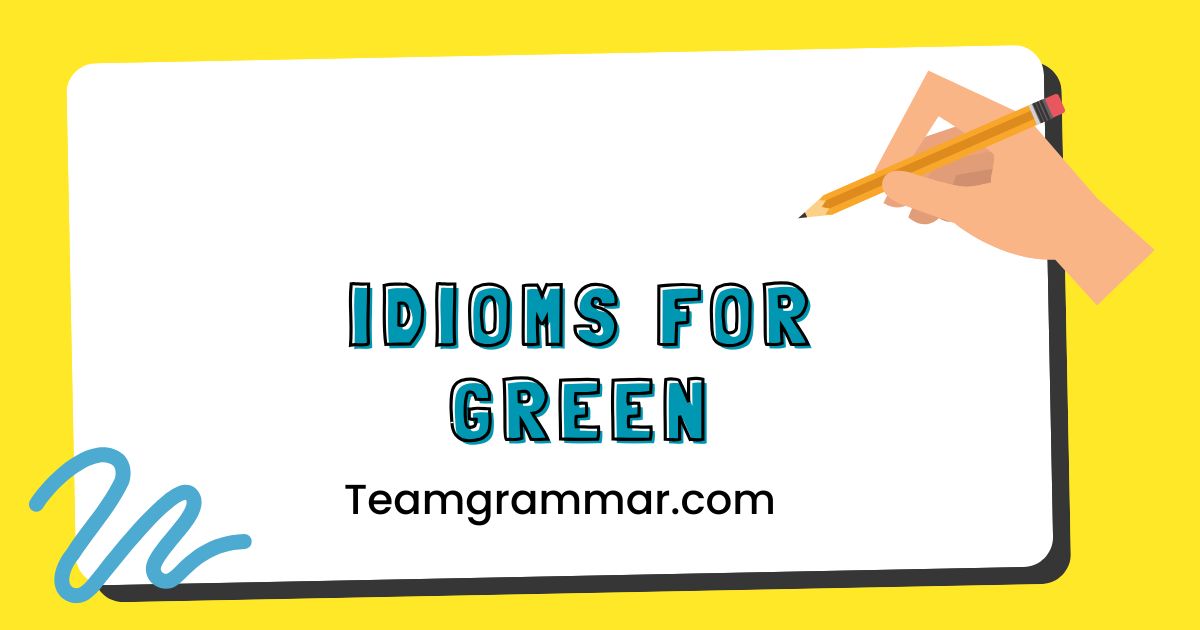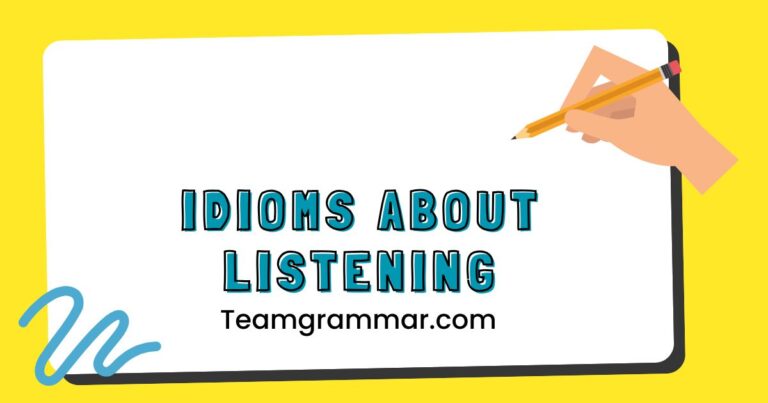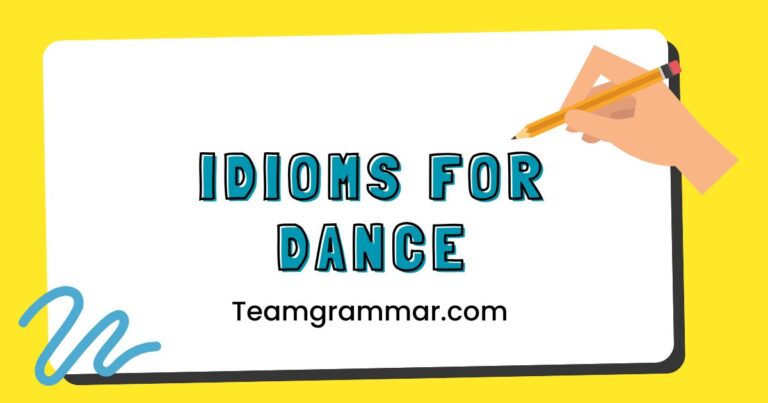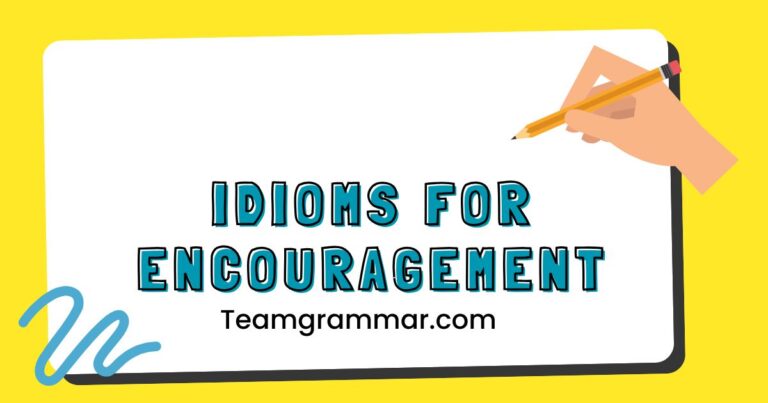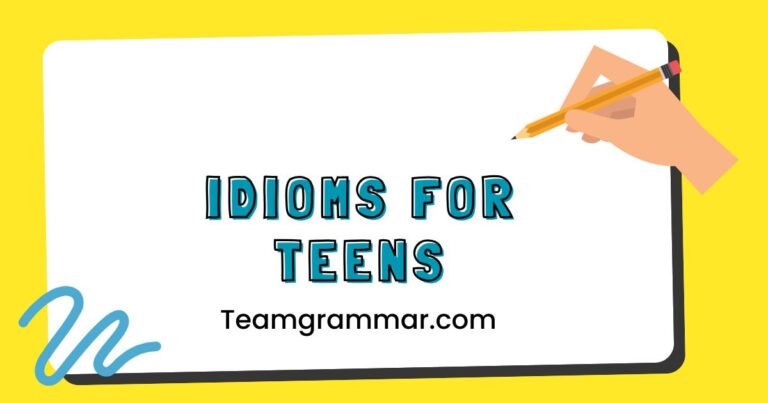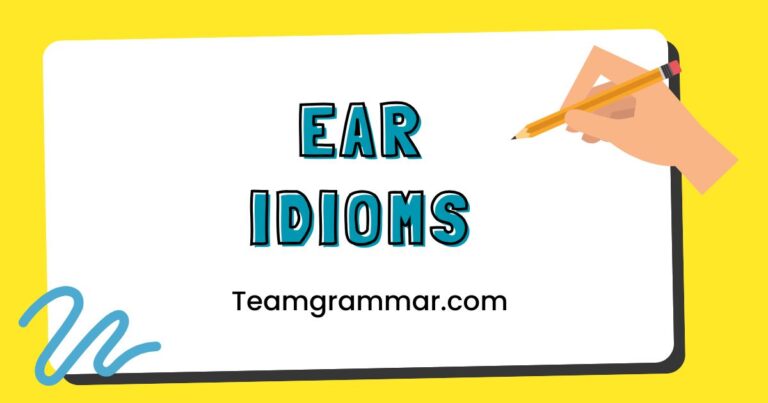35 Idioms for Green: Mastering English Expressions
Understanding idioms is crucial for mastering English, as they add color and depth to communication. Idioms related to the color “green” are particularly rich in meaning, reflecting various aspects of life, from nature and inexperience to envy and wealth.
This article provides a comprehensive guide to common English idioms featuring the word “green,” helping learners expand their vocabulary and improve their comprehension of both spoken and written English. This guide is perfect for ESL learners, students preparing for English proficiency exams, or anyone looking to enhance their understanding of idiomatic expressions.
This resource will help you not only understand these idioms but also use them correctly in different contexts.
Table of Contents
- Introduction
- Definition of Idioms and Green Idioms
- Structural Breakdown of Green Idioms
- Types and Categories of Green Idioms
- Examples of Green Idioms
- Usage Rules for Green Idioms
- Common Mistakes with Green Idioms
- Practice Exercises
- Advanced Topics: Nuances and Regional Variations
- FAQ: Frequently Asked Questions
- Conclusion
Definition of Idioms and Green Idioms
An idiom is a phrase or expression whose meaning cannot be understood from the literal meanings of its individual words. Instead, an idiom’s meaning is figurative and culturally specific.
Idioms enrich the English language, adding layers of meaning and nuance that go beyond simple literal interpretations. They often reflect cultural values, historical contexts, and shared experiences.
Green idioms are phrases that incorporate the word “green” to convey meanings related to various concepts, such as envy, inexperience, environmental awareness, or even illness. The color green itself often symbolizes nature, growth, freshness, and renewal, but in idioms, it can take on a variety of metaphorical meanings.
For example, the idiom “green with envy” doesn’t literally mean someone’s skin turns green. Instead, it signifies that they are intensely jealous or resentful of someone else’s good fortune or possessions.
Understanding the context in which these idioms are used is essential for accurate interpretation and effective communication.
Structural Breakdown of Green Idioms
Green idioms can be structurally diverse, taking the form of phrases, clauses, or even complete sentences. They often involve a combination of the word “green” with nouns, verbs, adjectives, and prepositions to create unique and evocative expressions.
Analyzing the structural components of these idioms can help learners understand how they function within sentences and how their meanings are constructed.
One common structure involves “green” as an adjective modifying a noun, such as in “greenhorn,” which refers to an inexperienced person. Another structure involves “green” in prepositional phrases, such as “give the green light,” which means to grant permission or approval.
Understanding these structural patterns can aid in deciphering the meaning of unfamiliar green idioms.
Consider the idiom “the grass is always greener on the other side.” This idiom uses “greener” as a comparative adjective to imply that other people’s situations always seem more desirable than one’s own. The structure of this idiom reinforces its meaning by highlighting the perceived difference between one’s current situation and an imagined better one.
Types and Categories of Green Idioms
Green idioms can be categorized based on the concepts they represent. Here are some common categories:
1. Envy and Jealousy
These idioms use “green” to express feelings of jealousy or resentment towards someone else’s success, possessions, or opportunities.
2. Inexperience and Naivety
Idioms in this category use “green” to describe someone who is new to a particular activity or situation, often implying a lack of knowledge or skill.
3. Environmental Awareness
With growing concerns about environmental issues, some idioms use “green” to refer to eco-friendly practices, sustainable initiatives, or environmental activism.
4. Permission and Approval
These idioms use “green” to indicate that something is allowed or approved, often in a business or bureaucratic context.
5. Illness and Sickness
Although less common, some idioms use “green” to describe a state of being unwell or nauseous.
Examples of Green Idioms
Here are examples of green idioms, categorized for clarity. Each category includes a table with the idiom, its meaning, and example sentences to illustrate usage.
1. Envy and Jealousy
The following table contains idioms that relate to envy and jealousy. They all use the word “green” to convey a feeling of resentment or longing for what someone else has.
| Idiom | Meaning | Example Sentence |
|---|---|---|
| Green with envy | Extremely jealous or resentful | She was green with envy when she saw his new car. |
| Green-eyed monster | Jealousy | Jealousy is often referred to as the green-eyed monster. |
| See green | To be extremely angry or jealous | He saw green when he found out his colleague got the promotion. |
| Turn green with envy | To become very jealous | She turned green with envy at her friend’s success. |
| A touch of green | A slight feeling of envy | I felt a touch of green when I heard about their vacation. |
| Green around the gills | Looking sick or nauseous, sometimes due to jealousy | He looked green around the gills after hearing about her promotion, likely from envy. |
| Green with spite | Full of malicious envy | She was green with spite when her rival won the award. |
| Be green over | To be envious of something | He was green over her new job. |
| Feel green | To experience a feeling of envy | I began to feel green when they showed off their expensive purchases. |
| Green in the face | Appearing jealous or ill | He was green in the face when he saw her with another man. |
| Green with jealousy | Overcome with jealousy | She was green with jealousy when she saw his success. |
| Green thoughts | Thoughts filled with envy | He had green thoughts as he watched his neighbor’s success. |
| A green look | An envious expression | She gave him a green look when he showed off his new watch. |
| Green with resentment | Filled with resentment due to envy | He was green with resentment towards his colleague’s promotion. |
| Green in one’s soul | Deeply envious | He was green in his soul, unable to hide his jealousy. |
| Green with bitterness | Extremely bitter from envy | She was green with bitterness after losing the competition. |
| Green heart | A heart filled with envy | He had a green heart, constantly envying others’ achievements. |
| See another side green | To see a different, envious perspective | He began to see another side green when he realized his friend was more successful. |
| Green in the eyes | Having an envious look | She was green in the eyes as she watched the couple dance. |
| Green to the core | Envious through and through | He was green to the core, always wanting what others had. |
| Green with longing | Filled with a deep longing due to envy | She was green with longing as she watched the family celebrate. |
| Green with desire | Intensely desiring what someone else has | He was green with desire for the lifestyle his friend led. |
| Green with covetousness | Full of covetous envy | She was green with covetousness when she saw the diamond ring. |
| Green with a vengeance | Envious in an extreme and vengeful way | He was green with a vengeance, plotting to undermine his rival. |
| Green with unhappiness | Unhappy due to envy | She was green with unhappiness, always comparing herself to others. |
2. Inexperience and Naivety
This section focuses on idioms where “green” signifies a lack of experience or knowledge. These expressions are often used to describe someone who is new to a situation or task.
| Idiom | Meaning | Example Sentence |
|---|---|---|
| Greenhorn | An inexperienced person; a novice | He’s a greenhorn when it comes to coding, but he’s eager to learn. |
| Green around the ears | Naive and inexperienced | She’s still green around the ears, so she needs guidance. |
| Wet behind the ears | Young and inexperienced | He’s a bit wet behind the ears to handle such a complex project. |
| A bit green | Slightly inexperienced | I’m still a bit green at public speaking. |
| Green in the trade | New to a particular profession or industry | He’s green in the trade, but he shows great potential. |
| Green at the job | Inexperienced in a specific role | She’s green at the job, so be patient with her learning curve. |
| A green recruit | A new and inexperienced member | He’s a green recruit, fresh out of training. |
| Green in business | New to the world of commerce | She’s green in business and needs a mentor. |
| Green on the team | A newcomer to the group | He’s green on the team, so introduce him to everyone. |
| Green to the ways | Unfamiliar with certain customs or practices | She’s green to the ways of the city. |
| Green in the field | Inexperienced in a particular area of expertise | He’s green in the field of engineering. |
| Green to the world | Naive and unaware of life’s realities | She’s green to the world and needs protection. |
| Green behind the ears | Very young and inexperienced | He’s still green behind the ears, fresh out of college. |
| Green in the ways of the world | Unfamiliar with worldly matters | She’s green in the ways of the world and easily impressed. |
| Green in the art | New to a particular skill or craft | He’s green in the art of negotiation. |
| Green in one’s experience | Lacking life experience | She’s green in her experience and hasn’t faced many challenges. |
| Green in knowledge | Lacking in knowledge or information | He’s green in knowledge about the topic. |
| Green at the wheel | Inexperienced at driving | She’s green at the wheel and still learning the rules of the road. |
| Green in the saddle | New to riding a horse | He’s green in the saddle and needs lessons. |
| Green with youth | Inexperienced due to young age | She’s green with youth, but full of potential. |
| Green in the game | New to a particular activity or competition | He’s green in the game and still learning the strategies. |
| Green in the school | New to a particular educational institution | She’s green in the school, being a freshman. |
| Green in the city | Unfamiliar with urban life | He’s green in the city, having just moved from the countryside. |
| Green in the country | Unfamiliar with rural life | She’s green in the country, never having seen a farm before. |
| Green in the world of work | New to the professional environment | He’s green in the world of work and still adjusting. |
3. Environmental Awareness
In this category, “green” is used to denote eco-friendly practices, sustainability, and environmental consciousness. These idioms are increasingly relevant in today’s world.
| Idiom | Meaning | Example Sentence |
|---|---|---|
| Go green | To adopt environmentally friendly practices | We need to go green to protect our planet. |
| Green revolution | A significant shift towards sustainable practices | The green revolution is transforming the energy industry. |
| Green energy | Energy derived from renewable sources | We should invest more in green energy like solar and wind power. |
| Green building | Constructing buildings using sustainable materials and practices | Green building is becoming increasingly popular. |
| Green economy | An economy focused on sustainability and environmental protection | The green economy offers new opportunities for innovation. |
| Green technology | Technology aimed at reducing environmental impact | Green technology is essential for a sustainable future. |
| Green initiative | A project or plan designed to promote environmental sustainability | The company launched a green initiative to reduce its carbon footprint. |
| Green living | A lifestyle focused on reducing environmental impact | She practices green living by recycling and conserving energy. |
| Green movement | A social and political movement focused on environmental issues | The green movement is gaining momentum worldwide. |
| Green product | A product designed to be environmentally friendly | Consumers are increasingly demanding green products. |
| Green policies | Governmental regulations aimed at protecting the environment | The government is implementing green policies to combat climate change. |
| Green investment | Investing in environmentally friendly projects and companies | Green investment is crucial for a sustainable future. |
| Green jobs | Employment opportunities in the environmental sector | The green jobs sector is growing rapidly. |
| Green business | A business that operates in an environmentally sustainable manner | She runs a green business that focuses on eco-friendly products. |
| Green consumerism | The practice of purchasing environmentally friendly products | Green consumerism is driving demand for sustainable goods. |
| Green education | Educational programs focused on environmental awareness | Green education is essential for future generations. |
| Green practices | Environmentally sustainable methods and procedures | The company is adopting green practices to reduce waste. |
| Green solutions | Environmentally friendly approaches to solving problems | We need green solutions to address climate change. |
| Green thinking | A mindset focused on environmental sustainability | Green thinking is essential for a sustainable future. |
| Green vision | A long-term plan for environmental sustainability | The city has a green vision for a cleaner future. |
| Green future | A future characterized by environmental sustainability | We must work towards a green future for our children. |
| Green earth | A planet that is environmentally healthy | We strive to leave behind a green earth for future generations. |
| Green world | A world focused on environmental sustainability | The goal is to create a green world where nature and humanity coexist harmoniously. |
| Green planet | A planet with a thriving ecosystem and sustainable practices | Our mission is to preserve and protect our green planet. |
| Green living space | A personal or communal area designed to promote environmental sustainability | They transformed their backyard into a green living space with native plants and a compost bin. |
4. Permission and Approval
These idioms use “green” to signify permission, approval, or the go-ahead for a particular action or project. They are commonly used in business and bureaucratic contexts.
| Idiom | Meaning | Example Sentence |
|---|---|---|
| Give the green light | To grant permission or approval | The project received the green light from the board of directors. |
| Green light for | Approval to proceed with something | We have the green light for the new marketing campaign. |
| Get the green light | To receive permission or approval | We’re waiting to get the green light before starting the project. |
| A green signal | A sign of approval or permission | The investors gave us a green signal to proceed. |
| Pass with flying colors | To succeed brilliantly; often used when approval is given enthusiastically | He passed with flying colors, earning the team’s full support. |
| Approved to proceed | Having formal permission to move forward | We are approved to proceed with the next phase of development. |
| Green stamp of approval | Official endorsement or authorization | The product received the green stamp of approval from the regulatory agency. |
| Authorize the green light | To officially permit or sanction | The CEO decided to authorize the green light for the new initiative. |
| Grant the green light | To provide formal permission | The government decided to grant the green light for the construction project. |
| Given a green card | To receive formal permission to live and work in a country (though not directly related to “green” in the same sense, it implies permission). | She was given a green card after years of waiting. |
5. Illness and Sickness
Although less common, some idioms use “green” to describe a state of being unwell or nauseous. These idioms often relate to physical discomfort or sickness.
| Idiom | Meaning | Example Sentence |
|---|---|---|
| Green around the gills | Looking sick or nauseous | He looked green around the gills after the roller coaster ride. |
| Turn green | To become pale or sickly | She started to turn green and felt faint. |
| Feel green | To feel unwell or nauseous | I feel green after eating that strange food. |
| Look green | To appear unwell or sick | He looked green and stayed home from work. |
| A green pallor | A sickly, pale complexion | She had a green pallor, indicating she was not feeling well. |
Usage Rules for Green Idioms
Using idioms correctly requires understanding their specific meanings and contexts. Here are some general rules to follow when using green idioms:
- Understand the Meaning: Before using an idiom, make sure you fully understand its figurative meaning. Don’t rely on the literal definitions of the individual words.
- Consider the Context: Idioms are context-dependent. Use them in situations where their figurative meaning is appropriate.
- Avoid Overuse: While idioms can add color to your language, overuse can make your speech sound unnatural or forced.
- Be Aware of Regional Variations: Some idioms are more common in certain regions or dialects than others. Be mindful of your audience.
- Use Correct Grammar: Ensure that the idiom fits grammatically within the sentence. For example, use the correct verb tense and subject-verb agreement.
For example, it would be incorrect to say “He is green with happy” because the idiom is “green with envy,” which expresses jealousy, not happiness. Similarly, using “go green” in a context unrelated to environmentalism would be confusing.
Common Mistakes with Green Idioms
Learners often make mistakes when using idioms, particularly when they are not familiar with the figurative meanings or proper contexts. Here are some common errors to avoid:
| Incorrect | Correct | Explanation |
|---|---|---|
| She was blue with envy. | She was green with envy. | The correct color is “green,” not “blue,” to express jealousy. |
| He is a redhorn in the company. | He is a greenhorn in the company. | The idiom for an inexperienced person is “greenhorn,” not “redhorn.” |
| They gave the red light to the project. | They gave the green light to the project. | “Green light” signifies approval, while “red light” signifies rejection. |
| I feel blue around the gills. | I feel green around the gills. | “Green around the gills” indicates sickness, not “blue.” |
| We should go red to save the environment. | We should go green to save the environment. | “Go green” refers to adopting eco-friendly practices. |
Another common mistake is misinterpreting the idiom literally. For example, someone might think “green around the gills” means someone’s skin is actually green, rather than understanding it as a sign of nausea.
Always remember that idioms have figurative meanings.
Practice Exercises
Test your understanding of green idioms with these exercises. Fill in the blanks with the appropriate idiom from the list provided.
Idiom List: green with envy, greenhorn, give the green light, green around the gills, go green
| Question | Answer |
|---|---|
| 1. She was __________ when she saw his new sports car. | green with envy |
| 2. The manager decided to __________ to the project after reviewing the proposal. | give the green light |
| 3. He’s a __________ when it comes to cooking, but he’s eager to learn. | greenhorn |
| 4. After the long flight, he looked __________. | green around the gills |
| 5. The company is encouraging employees to __________ and reduce waste. | go green |
| 6. The new intern is a complete ______, but he has a great attitude. | greenhorn |
| 7. She turned __________ when she heard about her friend’s promotion. | green with envy |
| 8. They finally decided to __________ to the construction of the new school. | give the green light |
| 9. He felt __________ after eating the questionable sushi. | green around the gills |
| 10. More and more people are trying to __________ to help the environment. | go green |
Exercise 2: Choose the correct meaning of the following green idioms.
| Question | Options | Answer |
|---|---|---|
| 1. What does “green with envy” mean? | a) Feeling happy b) Feeling jealous c) Feeling sad | b) Feeling jealous |
| 2. What does “greenhorn” mean? | a) An experienced person b) An inexperienced person c) A wise person | b) An inexperienced person |
| 3. What does “give the green light” mean? | a) To stop something b) To start something c) To approve something | c) To approve something |
| 4. What does “green around the gills” mean? | a) Feeling healthy b) Feeling sick c) Feeling energetic | b) Feeling sick |
| 5. What does “go green” mean? | a) To ignore the environment b) To harm the environment c) To protect the environment | c) To protect the environment |
| 6. If someone is described as “wet behind the ears,” what does it imply? | a) They are experienced b) They are naive c) They are knowledgeable | b) They are naive |
| 7. What does it mean if a project “gets the green light”? | a) The project is cancelled b) The project is approved c) The project is delayed | b) The project is approved |
| 8. If you “see green,” what are you likely feeling? | a) Happiness b) Anger c) Peace | b) Anger |
| 9. What does “green energy” refer to? | a) Energy from fossil fuels b) Energy from nuclear power c) Energy from renewable sources | c) Energy from renewable sources |
| 10. If someone is “green to the ways of the world,” what does that suggest? | a) They are worldly b) They are naive c) They are sophisticated | b) They are naive |
Advanced Topics: Nuances and Regional Variations
For advanced learners, it’s important to delve into the nuances and regional variations of green idioms. Some idioms may have subtle differences in meaning depending on the context or the speaker’s intent.
Additionally, certain idioms may be more common in specific regions or dialects of English.
For instance, while “green with envy” is universally understood, the intensity of the envy conveyed can vary depending on the tone and non-verbal cues. Similarly, idioms related to environmental awareness may have different connotations in different cultures or communities, depending on their level of environmental consciousness.
Furthermore, some green idioms may be considered outdated or less common in modern English. For example, phrases like “green sickness” (an old term for anemia, particularly in young women) are rarely used today.
Being aware of these nuances and regional variations can help you use green idioms more effectively and avoid misunderstandings.
FAQ: Frequently Asked Questions
- What is an idiom?
An idiom is a phrase or expression whose meaning cannot be understood from the literal meanings of its individual words. It has a figurative meaning that is culturally specific.
- Why is it important to learn idioms?
Learning idioms is crucial for understanding native English speakers and for adding depth and color to your own communication. Idioms can make your language sound more natural and expressive.
- How can I learn idioms more effectively?
Read widely, listen to native speakers, and pay attention to the context in which idioms are used. Keep a notebook of new idioms and practice using them in your own speech and writing.
- Are idioms the same in all English-speaking countries?
No, idioms can vary significantly between different English-speaking countries and regions. Be aware of regional variations and use idioms that are appropriate for your audience.
- Is it okay to use idioms in formal writing?
It depends on the context. In general, it’s best to avoid idioms in very formal writing, such as academic papers or legal documents. However, they can be appropriate in less formal contexts, such as business reports or personal essays.
- What’s the difference between an idiom and a proverb?
An idiom is a phrase with a figurative meaning, while a proverb is a short, well-known saying that expresses a general truth or piece of advice. Proverbs often have a moral or practical message.
- Can I create my own idioms?
While you can certainly be creative with language, idioms are generally established expressions that are widely recognized and understood. Creating your own idioms may lead to confusion or misunderstandings.
- How do I know when to use an idiom?
Use idioms when you want to add color and expressiveness to your language, but be mindful of your audience and the context. Avoid overuse and make sure you understand the idiom’s meaning and connotations.
- What does it mean to “go green”?
“Go green” means to adopt environmentally friendly practices and reduce your environmental impact. This can include recycling, conserving energy, and using sustainable products.
- What does it mean to “give someone the green light”?
To “give someone the green light” means to grant them permission or approval to proceed with a project or activity. It’s often used in business or bureaucratic contexts.
- Why is jealousy called the “green-eyed monster”?
The association of green with jealousy dates back to Shakespeare, who used the phrase “green-eyed monster” in his play Othello. The color green has long been associated with envy, possibly because of its connection to bile, which was thought to cause feelings of anger and jealousy in ancient times.
Conclusion
Mastering idioms, especially those related to the color “green,” can significantly enhance your understanding and use of the English language. By understanding the nuances of these expressions, you can communicate more effectively, add color to your speech, and avoid common mistakes.
Remember to consider the context, understand the figurative meanings, and practice using idioms in your own conversations and writing.
Continue to expand your knowledge of idioms by reading widely, listening to native speakers, and paying attention to the ways in which idioms are used in different contexts. With practice and dedication, you can become proficient in using green idioms and other idiomatic expressions, enriching your communication skills and deepening your appreciation for the English language.

